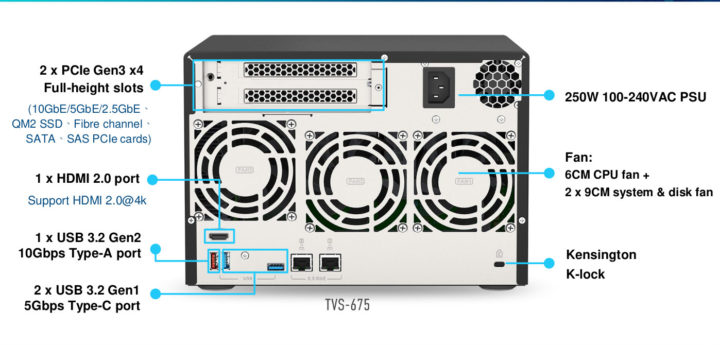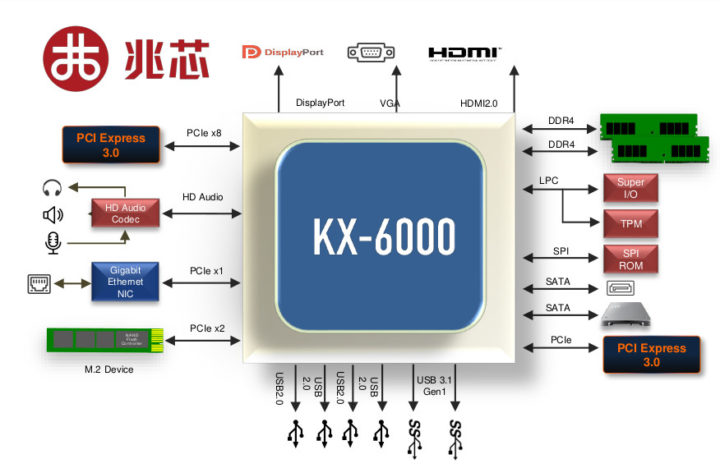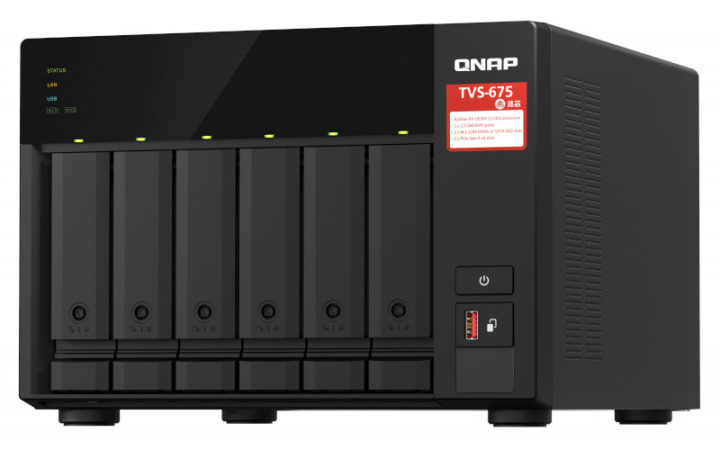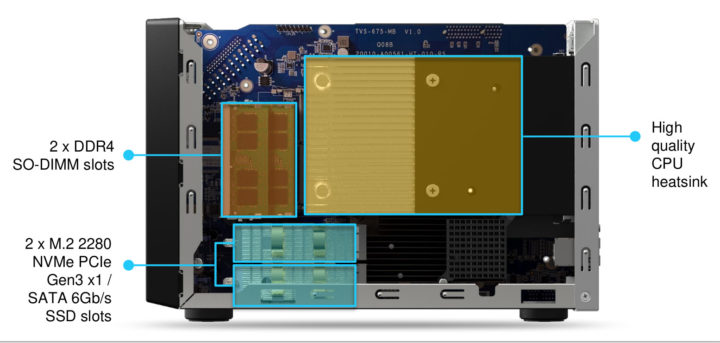QNAP has been trying something different in several in their new NAS recently. Last month, we covered QMiroPlus-201W that combines an Arm router and Intel NAS into one device, and now the company has announced another x86 NAS, but not based on Intel or AMD processor, but instead Zhaoxin’s 2.5 GHz eight-core KaiXian KX-U6580 processor.
QNAP TVS-675 NAS comes with 8GB RAM by default, six drive bays for hard drives or SSD’s, two M.2 2280 slots for SATA or NVMe storage, as well as two PCIe 3.0 x4 slots for networking, storage, or other expansion cards. The NAS also features 2.5GbE wired connectivity and an HDMI 2.0 to connect a display.
QNAP TVS-675 specifications:
- SoC – Zhaoxin KX-U6580 8-core/-thread 64-bit x86 processor @ 2.5GHz with FPU, AES-NI accelerator, 8MB L2 cache, ZhaoXin C-960 Graphics; 16nm process
- System Memory – 8 GB DDR4 single-channel; upgradable to up to 64GB dual-channel memory
- Storage
- 5GB flash storage (Dual boot OS protection)
- Drive Bay – 6x 3.5-inch SATA 6Gb/s compatible with 3.5-inch and 2.5-inch SATA HDD or SSD; Hot-swappable
- 2 x M.2 2280 PCIe Gen 3 x1 or SATA 6Gb/s slots with SSD Cache Acceleration Support
- Networking
- 2x 2.5 Gigabit Ethernet ports (2.5G/1G/100M)
- Optional 5 Gigabit Ethernet or 10 Gigabit Ethernet via adapter
- Wake on LAN (WOL) support on 2.5GbE ports
- Max. Number of Concurrent Connections (CIFS) – 2,000 with max. memory
- USB – 2x USB 3.2 Gen 1 ports, 2x USB 3.2 Gen 2 (10Gbps) ports
- Video Output – HDMI 2.0 up to 4Kp60
- Video – H.264/265 hardware transcoding support
- Expansion – 2x PCIe Gen 3 x4 slots
- Misc
- LED Indicators: HDD 1-6, Status, LAN, USB, M.2 SSD 1-2)
- Buttons: Power, Reset, USB Copy
- 3x 80mm 12V fans
- Buzzer
- Kensington lock support
- Power Supply – 250W, 100-240V AC, 50/60Hz, 3.5A
- Power Consumption – HDD Sleep Mode 41.897 W; operating mode: 60.794 W (typ.)
- Dimensions (HxWxD) – 188.2 × 263.9 × 280.8 mm
- Weight – 6.2 kg
- Temperature Range – Operating: 0 – 40°C; storage: -20 – 70°C
- Relative Humidity – 5-95% RH non-condensing, wet bulb: 27C (80.6F)

QNAP also offers a wide range of PCIe expansions cards for networking (5GbE, 10 GbE, WiFI 6, etc..), storage (M.2, SAS, etc..) , or a combination of the two.

Zhaoxin KX-U6580, and other KX-6000 series processors, are said to offer lower latency while running multi-task applications, hardware 4K video
transcoding, 4K video output via HDMI 2.0, and VT-x and IO virtualization
for running multiple virtual machines (VM).
While Zhaoxin x86 (and Arm) processors have mainly been found in products sold in mainline China, QNAP TVS-675 will be distributed worldwide. Performance-wise Zhaoxin KX-U6580 appears to offer performance similar to an Intel Celeron J4105 quad-core Gemini Lake processor, mostly due to the eight cores as single-thread performance is on the weaker side. It does not seem to be the most efficient processor either based on the NAS 40+ W idle power.
More details can be found on the product page, which also includes a 56-page presentation.
Via Liliputing and Tom’s Hardware

Jean-Luc started CNX Software in 2010 as a part-time endeavor, before quitting his job as a software engineering manager, and starting to write daily news, and reviews full time later in 2011.
Support CNX Software! Donate via cryptocurrencies, become a Patron on Patreon, or purchase goods on Amazon or Aliexpress






